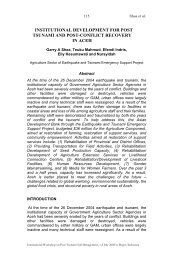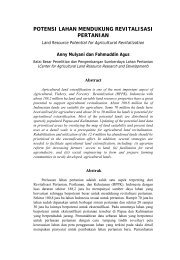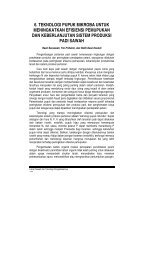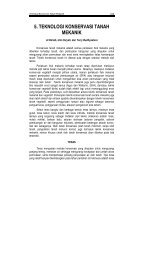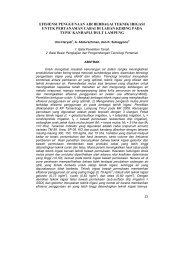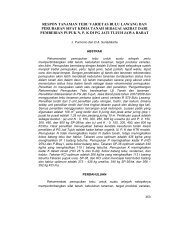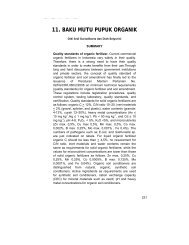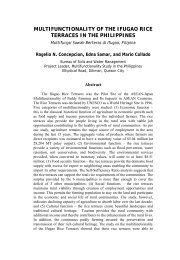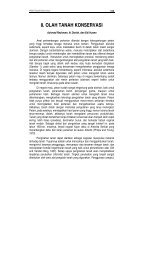Proceedings - Balai Penelitian Tanah
Proceedings - Balai Penelitian Tanah
Proceedings - Balai Penelitian Tanah
Create successful ePaper yourself
Turn your PDF publications into a flip-book with our unique Google optimized e-Paper software.
INTRODUCTION<br />
34<br />
Abubakar and Basri<br />
The December 26, 2004 earthquake and tsunami caused great impacts<br />
and change to the communities who live in coastal areas of Nanggroe<br />
Aceh Darussalam (NAD), including those who dependant on<br />
agriculture. The devastation included loos of life, damage to agricultural<br />
infrastructure, agricultural institutions, and agricultural supplies, and the<br />
marketing network.<br />
Data from the Rehabilitation and Reconstruction Blue Print shows that<br />
85,233 Ha of agricultural land was affected, consisting of 23,330 Ha rice<br />
field, 24,345 Ha dry land, and 37,558 Ha estate crops. Other damage<br />
include irrigation channels, agricultural machinary and loss of livestock<br />
and poultry (about 1.9 million heads).<br />
The most heavily damaged area is located in the western coastal<br />
districts of Aceh Besar, Aceh Jaya, Aceh Barat and Nagan Raya which<br />
are located in the western part of NAD. Damage to the eastern coastal<br />
districts of Pidie, Bireuen, Aceh Utara and Aceh Timur was not as<br />
severe.<br />
Three years after the tsunami the condition of damaged land has<br />
gradually changed. Field observations show that most of the light and<br />
medium damaged agriculutral land have been rehabilitated and used by<br />
farmers. However, the heaviest damaged land is not yet fully<br />
rehabilitated and has not been used optimally for cultivation.<br />
This paper is written to briefly describe post-tsunami rehabilitation and<br />
reconstruction of damaged agricultural land. The paper also shares<br />
experiences and obstacles faced in the field, and future actions to be<br />
considered to rehabilitate as yet unproductive land and promote<br />
livelihood activities.<br />
DAMAGE TO AGRICULTURAL LAND<br />
Tsunami-affected agricultural land can be divided into three categories,<br />
i.e. light damage, medium damage, and heavy damage. Light damage<br />
land identified by sediment of less than 10 cm thickness, no mud, no silt<br />
and no eroded land. Medium damage land identified by sediment<br />
between 10 and 20 cm thickness, less than 50 % debris and mud on the<br />
land, and some eroded land. Heavily damaged land identified by<br />
sediment greater than 20 cm, more than 50 % land covered by debris<br />
and mud, and heavy erosion. There is also agricultural land permanently<br />
lost due to the erosive forces of the tsunami.<br />
Damaged agricultural land located on the eastern coast of Aceh, fell into<br />
the light damage catagory. Districts that has lightly damaged land are<br />
listed in Table 1. Damaged agricultural land on the west coast was<br />
catagorised as light (class A), medium (class B) and heavy (class C), as<br />
listed in Table 2.<br />
International Workshop on Post Tsunami Soil Management, 1-2 July 2008 in Bogor, Indonesia



